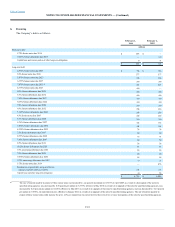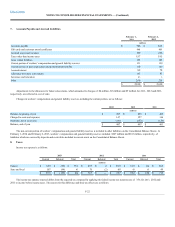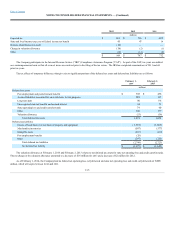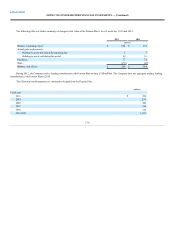Macy's 2013 Annual Report Download - page 73
Download and view the complete annual report
Please find page 73 of the 2013 Macy's annual report below. You can navigate through the pages in the report by either clicking on the pages listed below, or by using the keyword search tool below to find specific information within the annual report.-
 1
1 -
 2
2 -
 3
3 -
 4
4 -
 5
5 -
 6
6 -
 7
7 -
 8
8 -
 9
9 -
 10
10 -
 11
11 -
 12
12 -
 13
13 -
 14
14 -
 15
15 -
 16
16 -
 17
17 -
 18
18 -
 19
19 -
 20
20 -
 21
21 -
 22
22 -
 23
23 -
 24
24 -
 25
25 -
 26
26 -
 27
27 -
 28
28 -
 29
29 -
 30
30 -
 31
31 -
 32
32 -
 33
33 -
 34
34 -
 35
35 -
 36
36 -
 37
37 -
 38
38 -
 39
39 -
 40
40 -
 41
41 -
 42
42 -
 43
43 -
 44
44 -
 45
45 -
 46
46 -
 47
47 -
 48
48 -
 49
49 -
 50
50 -
 51
51 -
 52
52 -
 53
53 -
 54
54 -
 55
55 -
 56
56 -
 57
57 -
 58
58 -
 59
59 -
 60
60 -
 61
61 -
 62
62 -
 63
63 -
 64
64 -
 65
65 -
 66
66 -
 67
67 -
 68
68 -
 69
69 -
 70
70 -
 71
71 -
 72
72 -
 73
73 -
 74
74 -
 75
75 -
 76
76 -
 77
77 -
 78
78 -
 79
79 -
 80
80 -
 81
81 -
 82
82 -
 83
83 -
 84
84 -
 85
85 -
 86
86 -
 87
87 -
 88
88 -
 89
89 -
 90
90 -
 91
91 -
 92
92 -
 93
93 -
 94
94 -
 95
95 -
 96
96 -
 97
97 -
 98
98 -
 99
99 -
 100
100 -
 101
101 -
 102
102 -
 103
103 -
 104
104 -
 105
105 -
 106
106 -
 107
107 -
 108
108 -
 109
109 -
 110
110 -
 111
111 -
 112
112 -
 113
113 -
 114
114 -
 115
115 -
 116
116 -
 117
117 -
 118
118 -
 119
119 -
 120
120 -
 121
121 -
 122
122 -
 123
123 -
 124
124 -
 125
125 -
 126
126 -
 127
127 -
 128
128 -
 129
129 -
 130
130 -
 131
131 -
 132
132 -
 133
133 -
 134
134 -
 135
135 -
 136
136 -
 137
137 -
 138
138 -
 139
139 -
 140
140 -
 141
141 -
 142
142 -
 143
143 -
 144
144 -
 145
145 -
 146
146 -
 147
147 -
 148
148 -
 149
149 -
 150
150 -
 151
151 -
 152
152 -
 153
153 -
 154
154 -
 155
155 -
 156
156 -
 157
157 -
 158
158 -
 159
159 -
 160
160 -
 161
161 -
 162
162 -
 163
163 -
 164
164 -
 165
165 -
 166
166 -
 167
167 -
 168
168 -
 169
169 -
 170
170 -
 171
171 -
 172
172 -
 173
173 -
 174
174 -
 175
175 -
 176
176 -
 177
177 -
 178
178 -
 179
179 -
 180
180 -
 181
181 -
 182
182 -
 183
183 -
 184
184 -
 185
185 -
 186
186 -
 187
187 -
 188
188 -
 189
189 -
 190
190 -
 191
191 -
 192
192 -
 193
193 -
 194
194 -
 195
195 -
 196
196 -
 197
197 -
 198
198 -
 199
199 -
 200
200 -
 201
201 -
 202
202 -
 203
203 -
 204
204 -
 205
205 -
 206
206 -
 207
207 -
 208
208 -
 209
209 -
 210
210 -
 211
211 -
 212
212 -
 213
213 -
 214
214 -
 215
215 -
 216
216 -
 217
217 -
 218
218 -
 219
219 -
 220
220 -
 221
221 -
 222
222 -
 223
223 -
 224
224 -
 225
225 -
 226
226 -
 227
227 -
 228
228 -
 229
229 -
 230
230 -
 231
231 -
 232
232 -
 233
233 -
 234
234 -
 235
235 -
 236
236 -
 237
237 -
 238
238 -
 239
239 -
 240
240 -
 241
241 -
 242
242 -
 243
243 -
 244
244 -
 245
245 -
 246
246 -
 247
247 -
 248
248 -
 249
249 -
 250
250 -
 251
251 -
 252
252 -
 253
253 -
 254
254 -
 255
255 -
 256
256 -
 257
257 -
 258
258 -
 259
259 -
 260
260 -
 261
261 -
 262
262 -
 263
263 -
 264
264 -
 265
265 -
 266
266 -
 267
267 -
 268
268 -
 269
269 -
 270
270 -
 271
271 -
 272
272 -
 273
273 -
 274
274 -
 275
275 -
 276
276 -
 277
277 -
 278
278 -
 279
279 -
 280
280 -
 281
281 -
 282
282 -
 283
283 -
 284
284 -
 285
285 -
 286
286 -
 287
287 -
 288
288
 |
 |

Table of Contents
The Company develops its expected long-term rate of return on plan asset assumption by evaluating input from several professional advisors taking into
account the asset allocation of the portfolio and long-term asset class return expectations, as well as long-term inflation assumptions. Expected returns for each
major asset class are considered along with their volatility and the expected correlations among them. These expectations are based upon historical relationships
as well as forecasts of how future returns may vary from historical returns. Returns by asset class and correlations among asset classes are combined using
the target asset allocation to derive an expected return for the portfolio as a whole. Long-term historical returns of the portfolio are also considered. Portfolio
returns are calculated net of all expenses, therefore, the Company also analyzes expected costs and expenses, including investment management fees,
administrative expenses, Pension Benefit Guaranty Corporation premiums and other costs and expenses. As of February 2, 2013, the Company lowered the
assumed annual long-term rate of return for the Pension Plan's assets from 8.00% to 7.50% based on expected future returns on the portfolio.
The Company develops its rate of compensation increase assumption based on recent experience and reflects an estimate of future compensation levels
taking into account general increase levels, seniority, promotions and other factors. The salary increase assumption is used to project employees’ pay in future
years and its impact on the projected benefit obligation for the Pension Plan.
The assets of the Pension Plan are managed by investment specialists with the primary objectives of payment of benefit obligations to Plan participants
and an ultimate realization of investment returns over longer periods in excess of inflation. The Company employs a total return investment approach whereby
a mix of domestic and foreign equity securities, fixed income securities and other investments is used to maximize the long-term return on the assets of the
Pension Plan for a prudent level of risk. Risks are mitigated through the asset diversification and the use of multiple investment managers. The target
allocation for plan assets is currently 50% equity securities, 40% debt securities, 5% real estate and 5% private equities.
The Company generally employs investment managers to specialize in a specific asset class. These managers are chosen and monitored with the
assistance of professional advisors, using criteria that include organizational structure, investment philosophy, investment process, performance compared to
market benchmarks and peer groups.
The Company periodically conducts an analysis of the behavior of the Pension Plan’s assets and liabilities under various economic and interest rate
scenarios to ensure that the long-term target asset allocation is appropriate given the liabilities.
F-27
